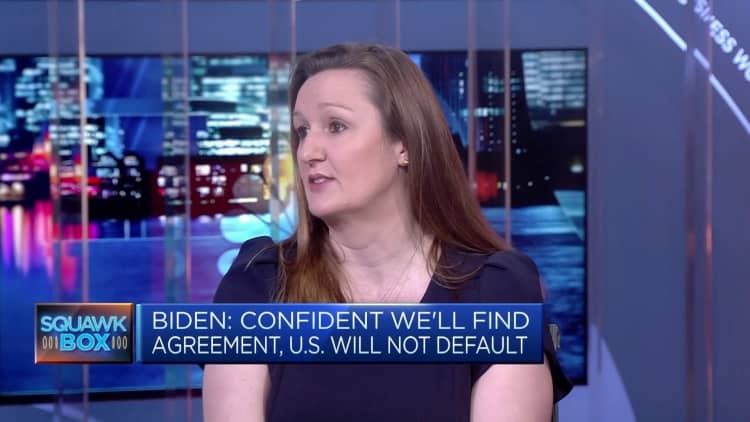HIROSHIMA, JAPAN – MAY 17: People walk under a banner promoting the Group of Seven (G7) summit on a shopping street in Hiroshima, Japan on May 17, 2023. The G7 summit will be held in Hiroshima from May 19th to 22nd. (Photo: Tomohiro Ohsumi/Getty Images)
Tomohiro Ohsumi | Getty Images News | Getty Images
Global debt rose by $8.3 trillion to a near-record high of $305 trillion in the first quarter as the global economy faced an “adaptation crisis” to rapid monetary tightening by central banks, according to a closely watched report. Institute of International Finance.
The combination of such high debt levels and rising interest rates has driven up the cost of servicing debt and raised concerns about leverage in the financial system, the financial industry body said.
Central banks around the world have been raising interest rates for more than a year to curb high inflation. The Fed raised the federal funds rate to a target range of 5% to 5.25% earlier this month, the highest level since August 2007.
“With financial conditions at their tightest levels since the 2008-09 financial crisis, tighter credit will lead to higher defaults and lead to more ‘zombies’ – estimated already at nearly 14% of US public companies,” the IIF said. in the quarterly Global Debt Monitor report later on Wednesday.
Global debt burdens rose sharply in the three months to the end of March, the second straight quarterly increase after two straight quarters of sharp declines during last year’s aggressive monetary policy tightening. Non-financial corporations and the government sector drove most of the rebound.
“Global debt at nearly $305 trillion, now $45 trillion higher than pre-pandemic levels, is expected to continue growing rapidly: Government borrowing demand rises despite fears of possible credit crunch following recent turmoil in U.S. and Swiss banking sectors Still high,” the IIF said.

Aging populations, rising health care costs and a large climate financing gap are putting pressure on government balance sheets, the Washington, D.C.-based group said. The IIF expects that defense spending is expected to increase in the medium term due to heightened geopolitical tensions, which could affect the credit profile of government and corporate borrowers.
“If this trend continues, it will have significant implications for international debt markets, especially if interest rates remain elevated for an extended period,” the report states.
Total debt in emerging markets hit a record high of more than $100 trillion in 2019, from $75 trillion in 2019, or about 250% of GDP. China, Mexico, Brazil, India and Turkey were the largest growth contributors.
Among developed markets, Japan, the US, France and the UK recorded the largest increases during the quarter.
Banking turmoil and ‘adaptation to the crisis’
Tight monetary policy has exposed the fragile liquidity positions of many small and medium-sized banks in the United States and led to a series of failures and bailouts in recent months.The ensuing market panic eventually spilled over to Europe, forcing an emergency sale by the Swiss giant credit suisse arrive Swiss bank.
The IIF said businesses had already experienced an “adaptation crisis” to what it called the “new monetary regime”.
“While the recent bank failures appear to be more idiosyncratic than systemic – and US financial institutions have much less debt (78% of GDP) than they did on the eve of the 2007/8 crisis (110% in 2006) – — but fears of contagion have triggered deposit withdrawals significantly affecting U.S. regional banks,” the IIF said.

“Given the central role of regional banks in U.S. credit intermediation, concerns about their liquidity positions could lead to a sharp contraction in lending to some sectors, including underbanked households and businesses.”
This contraction in credit conditions could disproportionately affect small businesses, leading to higher default rates and more “zombie firms,” the IIF said.
A zombie business is a company that earns enough to keep it afloat and pay interest on its debt but is unable to service its debt, meaning any cash generated is immediately used to pay down debt. The company is thus “neither dead nor alive”.
“We estimate that about 14 percent of U.S. companies could be considered zombies, a significant portion of which are in the healthcare and information technology sectors.”


